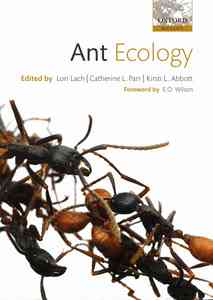Ants in the intertidal zone: colony and behavioral adaptations for survival
Robson, Simon (2010) Ants in the intertidal zone: colony and behavioral adaptations for survival. In: Lach, Lori, Parr, Catherine L., and Abbott, Kirsti L., (eds.) Ant Ecology. Oxford University Press, Oxford, pp. 185-186.
![[img]](https://researchonline.jcu.edu.au/22491/3.hassmallThumbnailVersion/22491-robson-2010-cover.jpg)
|
Image (JPEG) (Book Cover)
- Cover Image
Download (229kB) |
|
|
PDF (Published Version)
- Published Version
Restricted to Repository staff only |
||
|
PDF (Accepted Version)
- Accepted Version
Restricted to Repository staff only |
Abstract
[Extract] The nests of Polyrhachis sokolova are restricted to the mangrove mud of northern Australia and nearby tropical countries, where colonies survive despite seemingly inhospitable conditions (Kohout 1988; Nielsen 1997). The intertidal zone of mangroves, situated at the interface between land and ocean, constantly changes with the tidal cycle. Nests are frequently covered by incoming tides, can remain submerged for up to 3.5 h during a normal tidal cycle (Nielsen 1997) and during extreme spring tides can be covered by as much as two metres of water (Shuetrim 2001). Foraging areas can therefore rapidly change from sand and mud to pools of hot salty water, and the nests themselves face a constant risk of invasion via the burrowing activity of numerous mangrove organisms such as crabs and mudskippers.
| Item ID: | 22491 |
|---|---|
| Item Type: | Book Chapter (Research - B1) |
| ISBN: | 978-0-19-954463-9 |
| Date Deposited: | 22 Aug 2012 00:59 |
| FoR Codes: | 06 BIOLOGICAL SCIENCES > 0602 Ecology > 060201 Behavioural Ecology @ 100% |
| SEO Codes: | 97 EXPANDING KNOWLEDGE > 970106 Expanding Knowledge in the Biological Sciences @ 100% |
| Downloads: |
Total: 647 Last 12 Months: 15 |
| More Statistics |



